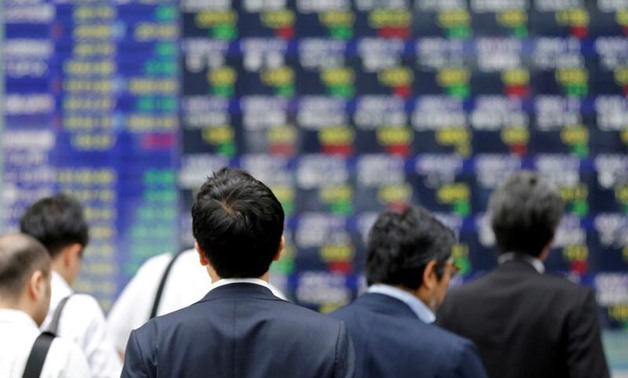
FILE PHOTO: People walk past an electronic stock quotation board outside a brokerage in Tokyo, Japan, September 22, 2017. REUTERS/Toru Hana
SYDNEY/TOKYO - 3 December 2018: Asian shares rallied on Monday after U.S. and Chinese leaders brokered a truce in their trade conflict, a relief for the global economic outlook and a tonic for emerging markets and battered oil prices.
Trade-exposed currencies led the early gains, with the Australian dollar notching a four-month peak, while the dollar dropped to one-month lows against the yuan CNH=.
E-Mini futures for the S&P 500 ESc1 climbed as much as 1.9 percent. MSCI’s broadest index of Asia-Pacific shares outside Japan .MIAPJ0000PUS jumped 1.8 percent.
China's CSI300 index of Shanghai and Shenzhen shares .CSI300 rose 2.6 percent. In Japan, the Nikkei .N225 gained 1.3 percent to a six-week high.
European shares are expected to follow suit, with futures for Britain's FTSE .FTSE, France's CAC .FCHI, Germany's DAX .GDAXI rising by 1.6 to 2.1 percent.
“Markets are opening with a knee-jerk boost to risk appetite but time will tell how enduring the optimism proves to be,” said ANZ economist Jo Masters. “There are already very different official takes on what was achieved at the meeting.”
“But for now, both sides can claim a win,” she added. “Perhaps not insignificantly, it provides a window to export the soybean crop from key Republican states, at least.”
China and the United States agreed to halt additional tariffs in a deal that keeps their trade war from escalating as the two sides try again to bridge their differences with fresh talks aimed at reaching a deal within 90 days.
The White House said on Saturday that President Donald Trump told Chinese President Xi Jinping during high-stakes talks in Argentina that he would not boost tariffs on $200 billion of Chinese goods to 25 percent on Jan. 1 as previously announced.
“Deeply contentious thornier structural issues such as forced technology transfer remain unresolved,” cautioned Westpac FX analyst Robert Rennie.
“This U.S.-China agreement is thus better characterized as a ‘mini-breakthrough’ that puts a momentary pause on trade tensions rather than a comprehensive policy deal.”
Indeed, many market players doubt the two countries can bridge their differences that cover a range of issues within three months.
“Technology is becoming the main battle ground. It’s not just a trade war any more. It’s more like a technology war, in which we just found a temporary lull,” said Hiroshi Watanabe, economist at Sony Financial.
And on the whole, there is still uncertainty over the outlook for corporate earnings amid signs of slowing growth.
For now though, investors chose to see the glass as half full and lifted the Aussie dollar 0.75 percent to $0.7360 AUD=D3.
The greenback eased against a basket of currencies to 96.993 =USD, but also firmed on the yen to 113.52 JPY=. The euro added 0.3 percent to $1.1345 EUR=.
The Mexican peso jumped more than 1 percent to 20.185 MXN=D3, helped also by reports that newly sworn-in Mexican President Andres Manuel Lopez Obrador may reverse his earlier plan to cancel construction of a new airport in the country's capital.
MSCI’s emerging currency index .MIEM00000CUS rose 0.4 percent to its highest levels in almost 4 months.
The dollar had come under pressure last week when comments by Federal Reserve Chair Jerome Powell were interpreted by markets as hinting at a slower pace of rate hikes.
Powell was scheduled to testify on Wednesday to a congressional Joint Economic Committee. But the hearing is expected to be postponed to Thursday because major exchanges will be closed on Wednesday in honor of former U.S. President George H.W. Bush, who died on Saturday at the age of 94.
Treasuries rallied hard late on Friday to leave 10-year yields down at 2.99 percent before bouncing back to 3.035 percent US10YT=RR early on Monday.
The progress on Sino-U.S. trade and an easier dollar provided some support to commodity prices.
Oil soared more than five percent, a positive start after it had posted its weakest month in more than 10 years in November, losing more than 20 percent as global supply outstripped demand. [O/R]
Speculation is high the Organization of the Petroleum Exporting Countries (OPEC) and Russia would agree some form of production cut at a meeting in Vienna on Thursday.
Brent futures LCOc1 rose $2.40 to trade at $61.86 a barrel, while U.S. crude CLc1 gained $2.28 to $53.21, both on course to make their biggest daily gains in over two years.
Chicago soybeans Sv1 climbed to their highest in almost six months, rising more than 2 percent at one point,
The gains were helped by a White House statement that said Beijing has agreed to buy an unspecified but “very substantial” amount of agricultural, energy, industrial and other products.
Over recent months, the tit-for-tat retaliatory tariffs have drastically curbed U.S. soybean exports to China, by far the world’s biggest bean importer.


Comments
Leave a Comment